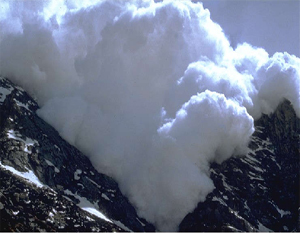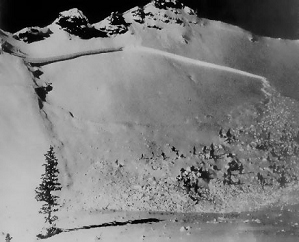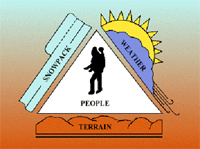Avalanche
| Introductions |
| 1. Avalanche is a dangerous and life threatening hazard in mountains. Mountain work in snow bound areas always envisage danger to life and property of our mountaineers. An avalanche seizes its victims in its deathly grip, throws it down steep slopes and kills it with its weight and pressure. Hence for safe mountain work in mountains and snow bound areas, it is a must for all climbers to have complete knowledge of avalanches. |
| Definition |
| 2. An avalanche is a massive mass of unstable snow and/or ice that can come hurtling down a slope and brings with it snow, ice, rocks, soil, trees etc. |
| Types of Avalanches | |
| 3. Avalanches can be classified into three types :-
|
|
|
(a) Loose snow avalanche. (b) Packed snow avalanche. (c) Combination avalanche. |
|
4. Loose Snow Avalanche. This type of avalanche comes on the slopes having loose snow. These avalanches start from a point and spread wide and deep while they come down . It is further subdivided into two types - Dry Snow Avalanche and Wet Snow Avalanche as explained below :- (a) Dry Snow Avalanche. This type of avalanche starts from a point and spreads deep and wide like a cone while it comes down. The speed of this type of avalanche is very fast, about 120 km per hr. It contains loose, powdery snow and forms a wind blast and snow dust cloud while coming down. Due to the high speed of the avalanche, it uproots trees on its way and kills the victims by suffocation (asphyxiation). |
|
|||||||||||||||
(b) Wet Snow Avalanche. This avalanche also starts from a point and it widens and deepens as it comes down. This type of avalanche is comparatively more dangerous due to more humidity in snow which makes its width less and height more .Due to more friction between snow particles, the avalanche stops suddenly creating a mass of hard snow. It becomes difficult to dig out the victim from such types of avalanches. |
||||||||||||||||
| 5. Packed Snow Avalanche. This is the most dangerous form of avalanche. The snow can lie on the slope in an unstable condition for months. This spread of this avalanche is very wide and it comes down from one rupture line taking the entire slab down suddenly. Its weight is more than wet snow avalanche and speed is almost equal to dry snow avalanche. Its examples are, the wind slab avalanche, ice avalanche, cornice avalanche etc |
|
|||||||||||||||
| 6. Combination Avalanche. As evident from the name, it is a combination of any of the two or more types of avalanches as mentioned above. For example dry and wet snow avalanche, wet snow and wind slab avalanche etc. | ||||||||||||||||
| Factors Aiding Avalanche Formation. | ||||||||||||||||
| 7 Avalanches are more prone to slopes with more gradient. Most avalanches occur in slopes with gradient from 30o to 45o. Slopes falling in shadow are more prone to avalanches than those which receive adequate sun( Fig 3) . Different factors aiding avalanche formation are as follows:- | ||||||||||||||||
| (a) Weather. Weather has a very pronouncing effect in avalanche formation. Changes in weather help in formation of avalanches.
(b) Rainfall/Snowfall. Snowfall at the rate of 3 – 5 cm/hr and rainfall at the rate of 0.5 to 3.5 mm/hr help in creation of avalanches. (c) Wind – Speed and Direction. |
|
|||||||||||||||
| (i) Slab avalanches are triggered by wind speeds of 7 m/sec (25 km/hr) or more. (ii) Avalanches are triggered by wind speeds of 10 to 25 m/sec (36–90 km/hr) or more. (iii) Generally avalanches are not triggered on slopes receiving wind speed of more than 90km/hr. |
||||||||||||||||
| (d) Temperature. When fresh and warm snow layer is formed over old and comparatively cold snow, avalanches may occur. | ||||||||||||||||
(e) Clouds. A curtain of clouds on the sky is capable of traping the heat of the sun in the atmosphere causing rise in temperature resulting in avalanche formation. (f) Visibility. Poor visibility does not allow one to see too far. It is very important to see clearly and far to avoid avalanche prone slopes. (g) Snow Conditions. A pressure is exerted by the upper layers of snow on the lower layers. Weak and thin lower layer breaks due to the pressure which results in triggering of avalanches. Sometimes snow accumulates on one slope from another drifted by wind and with little wind or movement destabilises the snow, triggering an avalanche. Lesser accumulation on the upper slope does not mean that there is no threat of avalanches. (h) Fresh Snow. Fresh snowfall in following quantities over slopes mentioned below creates avalanches. |
||||||||||||||||
| (i) Unstable slopes - 30-40 cm (ii) Relatively stable slopes - 40-50 cm. (iii) Stable slopes - 50-60 cm. |
||||||||||||||||
| (j) Snow Temperature. | ||||||||||||||||
(i) Cold snow (Less than -10oC) aids slab avalanches. |
||||||||||||||||
| Situations Preceding Avalanches | ||||||||||||||||
| 8. Avalanches are likely to trigger under following conditions:- | ||||||||||||||||
| (a) Fresh snowfall with wind at the speed of 10-25m/sec. (b) Temperature rise during snow storm. (c) Weaker layers of snow lying under the surface. (d) First clear day after many days of bad weather. (e) Regular rainfall over snow surface. (f) Wet snow pack. (g) Stellar crystals accompanied by calm and cold conditions produce avalanches. (h) Settlement of only 10% or less snow since previous 24 hrs of snowfall. (j) Thundering noises on nearby slopes. (k) Improper adhesion between fresh warm snow and old cold snow. |
||||||||||||||||
| Triggers | ||||||||||||||||
| 9. Unstable snow conditions with the following four triggers create avalanches :- | ||||||||||||||||
| (a) Pressure. Pressure is exerted by fresh snow or due to humidity in the snow. When this pressure exeeds a certain limit, it weakens the internal layers of snow and its anchoring capability, triggering avalanches. (b) Shearing. Shearing of snow layers on a slope results in one portion moving separately, creating an avalanche. Shearing may be due to movement of men diagonally across the slope or because of fall of a mass of packed snow/cornice from top of the slope. (c) Temperature. Rise in temperature increases humidity in snow resulting in increased pressure. (d) Vibrations. This may be caused due to aerial waves or waves travelling through the earth’s surface. Aerial waves are caused due to a distant explosion or a flying aircraft. Ground waves are created by movement of heavy engineering vehicles, tanks or body of troops. Vibrations weaken the internal bonding of snow layers resulting in an avalanche. |
||||||||||||||||
| Conclusion 10. Avalanche is one of the most dangerous hazards in the mountains. It poses serious threat to life and property. Knowledge about this hazard and precautionary measure to be adopted will prevent loss of lives while operating in mountains. |
||||||||||||||||
Training
The Jawahar Institute of Mountaineering and Winter Sports (JIM&WS).
Contact Us
The Jawahar Institute of Mountaineering and Winter Sports (JIM&WS)
Address: Nunwan Pahalgam (J&K)
Telephone: 01936-243129
01936-243129 (Training Section)
01936-243002 (PA to Principal)
9906967831 (Training Clerk)
9906967822 (Sub centre, Sanasar)
9906967821 (CPIO)
E-mail CPIO: principal@jawaharinstitutepahalgam.com
Fax:01936-243129
E-mail: principal@jawaharinstitutepahalgam.com
© Copyright JAWAHAR INSTITUTE OF
MOUNTAINEERING & WINTER SPORTS NUNWAN, PAHALGAM.Corporate Mail
Design, Development and Hosting of Website by Say Technologies












